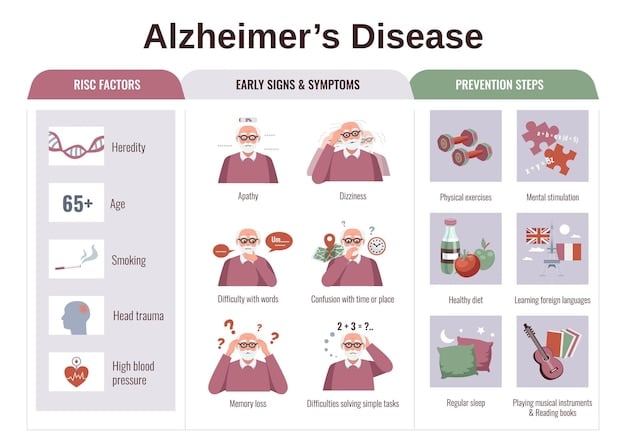Are You Vitamin D Deficient? The Surprising Symptoms to Watch For

Vitamin D deficiency is a widespread issue, but recognizing the symptoms, such as fatigue, bone pain, and mood changes, is the first step towards addressing it; simple strategies like diet adjustments and vitamin D supplements can help correct the deficiency within three months.
Do you often feel tired or experience unexplained bone pain? It might be more than just stress; you could be experiencing vitamin D deficiency. Identifying this deficiency is crucial, and the good news is that with the right approach, you can often fix it within three months.
Understanding Vitamin D Deficiency
Vitamin D, often dubbed the “sunshine vitamin,” is vital for many bodily functions. However, a significant portion of the US population is deficient. Let’s explore what this deficiency means and why it’s so common.
Vitamin D isn’t just a vitamin; it’s a hormone precursor that influences everything from bone health to immune function. When levels are low, it can impact your entire well-being. But why are so many people lacking this essential nutrient?
Factors Contributing to Deficiency
Several factors can lead to vitamin D deficiency:
- Limited Sun Exposure: Spending most of the day indoors or wearing sunscreen can drastically reduce vitamin D synthesis.
- Dietary Choices: A diet low in vitamin D-rich foods like fatty fish and fortified dairy can contribute to deficiency.
- Skin Pigmentation: Individuals with darker skin produce less vitamin D from sunlight compared to those with lighter skin.
- Geographic Location: Living in northern latitudes with less sunlight during winter months increases the risk.
Understanding these factors is the first step in addressing and preventing vitamin D deficiency.
In summary, Vitamin D deficiency is common due to elements like limited sun exposure, poor dietary habits and individual differences such as skin pigmentation or geographic location.
The Surprising Symptoms of Vitamin D Deficiency
Recognizing the symptoms of vitamin D deficiency can be challenging because they are often subtle or easily attributed to other causes. Knowing what to look for is crucial. Here are some key signs:

It’s easier to address a problem when you know the potential list of symptoms to look for.
Common and Less Obvious Symptoms
- Fatigue and Weakness: One of the most common signs of vitamin D deficiency is persistent tiredness and muscle weakness, impacting daily activities.
- Bone and Joint Pain: Vitamin D helps maintain bone health, so deficiency can manifest as aches and pains in your bones and joints.
- Mood Changes: Low vitamin D levels have been linked to mood swings, depression, and anxiety, affecting mental well-being.
While these are common issues that many may dismiss, they are also a primary indication that you may be lacking Vitamin D.
In conclusion, vitamin D deficiency presents in diverse ways, from physical fatigue and bone aches to changes in mood. Understanding and recognizing these signs allows for better management of an individual’s overall health and wellness.
How to Test for Vitamin D Deficiency
If you suspect you might be vitamin D deficient based on the symptoms, getting tested is the most accurate way to confirm. Here’s what you need to know about testing:
A simple blood test can reveal your vitamin D levels. Understanding the results will help you determine the best course of action.
Types of Vitamin D Tests
The most common test is the 25-hydroxyvitamin D blood test. This test measures the total amount of vitamin D in your blood, providing a clear indication of your status.
Understanding Your Results
- Deficient: Levels below 20 ng/mL indicate a deficiency requiring intervention.
- Insufficient: Levels between 20 and 30 ng/mL suggest you may need to increase your intake.
- Sufficient: Levels between 30 and 50 ng/mL are generally considered optimal for most people.
Knowing your levels is key to managing your health and ensuring you get the right amount of vitamin D.
Consequently, confirming vitamin D deficiency requires a simple blood test, and interpreting the results will help guide the next actions toward achieving optimal health.
The Importance of Vitamin D for Overall Health
Vitamin D plays a crucial role in maintaining overall health beyond just bone strength. Its deficiency can impact various aspects of your well-being. Let’s understand a few of the key areas that Vitamin D affects:
From immune function to mental health, vitamin D is essential for a healthy body and mind. Ensuring adequate levels can lead to significant improvements in various areas of your life.

Key Health Benefits
- Bone Health: Vitamin D helps the body absorb calcium, which is essential for strong bones and preventing osteoporosis.
- Immune Function: Adequate vitamin D levels support a healthy immune system, reducing the risk of infections and autoimmune diseases.
- Mental Health: Vitamin D influences neurotransmitter function, potentially reducing the risk of depression and anxiety.
Ensuring optimal levels can significantly improve your quality of life.
In short, vitamin D supports bone strength, boosts immune defense, and promotes mental health, making it essential for holistic well-being.
Fixing Vitamin D Deficiency in 3 Months
Correcting vitamin D deficiency typically involves increasing your vitamin D intake through diet, supplements, and sunlight exposure. Here’s a practical plan to help you improve your levels in about three months:
With a combination of lifestyle changes and targeted supplementation, you can effectively address vitamin D deficiency and improve your overall health.
Strategies for Increasing Vitamin D Levels
Combine these three strategies for best results:
- Dietary Adjustments: Incorporate foods rich in vitamin D, such as fatty fish (salmon, mackerel), egg yolks, and fortified foods like milk and cereals.
- Vitamin D Supplements: Take a daily vitamin D supplement. The recommended dose varies depending on your deficiency level, but typically ranges from 1,000 to 5,000 IU per day.
- Sun Exposure: Aim for 15-20 minutes of direct sunlight exposure on your skin several times a week, without sunscreen, during peak sunlight hours.
By consistently following these strategies, you can effectively improve your vitamin D levels and experience the health benefits.
To summarize, fixing vitamin D deficiency within three months requires a plan integrating diet, supplements, and regular sun exposure.
Maintaining Optimal Vitamin D Levels Long-Term
Once you’ve corrected your vitamin D deficiency, the goal is to maintain optimal levels for long-term health. This involves ongoing strategies and lifestyle adjustments.
Sustaining sufficient vitamin D levels requires a proactive and consistent approach. Making these practices part of your routine can help you stay healthy and prevent future deficiencies.
Long-Term Strategies
- Regular Monitoring: Get your vitamin D levels checked annually, especially if you have risk factors for deficiency.
- Consistent Supplementation: Continue taking a maintenance dose of vitamin D supplements, especially during winter months or periods of reduced sun exposure.
- Balanced Diet: Maintain a diet rich in vitamin D-containing foods to support overall nutrient intake.
By adopting these long-term strategies, you can ensure your vitamin D levels remain optimal, supporting your health and well-being for years to come.
Overall, sustaining high vitamin D levels for lasting well-being requires continual monitoring, consistent supplementation, and a well-rounded diet rich in essential nutrients.
| Key Point | Brief Description |
|---|---|
| ☀️ Sun Exposure | 15-20 minutes of daily sunlight helps boost Vitamin D. |
| 💊 Supplements | Vitamin D supplements can help correct deficiency. |
| 🐟 Diet | Eat foods rich in Vitamin D (fatty fish, eggs). |
| 🌡️ Regular Tests | Monitor vitamin D levels annually especially with risk factors. |
FAQ
▼
Vitamin D deficiency is often caused by inadequate sun exposure, poor dietary intake of vitamin D-rich foods, and certain health conditions that affect vitamin D absorption. Spending more time outdoors and adjusting one’s diet can often help.
▼
With consistent supplementation and lifestyle adjustments, such as diet changes and increased sun exposure, you can often correct a vitamin D deficiency within three months. Regular monitoring is key to achieving the goal.
▼
Yes, Vitamin D supplements are generally safe when taken at recommended doses. However, it’s essential to consult with a healthcare professional or doctor to determine the right dosage for your individual needs and to avoid potential Vitamin D toxicity.
▼
Yes, some medications, such as steroids and certain weight-loss drugs, can interfere with the absorption of vitamin D. If you’re on medication, discuss potential interactions with your doctor. This can help mitigate issues.
▼
While some foods contain vitamin D, it can be challenging to get enough solely from diet. Fatty fish, egg yolks, and fortified foods may help, but supplementation is often necessary to meet daily requirements, especially if deficient.
Conclusion
Understanding, identifying, and addressing vitamin D deficiency is crucial for maintaining overall well-being. By recognizing the symptoms, getting tested, and implementing strategies for correction and long-term maintenance, you can ensure optimal vitamin D levels and enjoy the many health benefits it offers.





